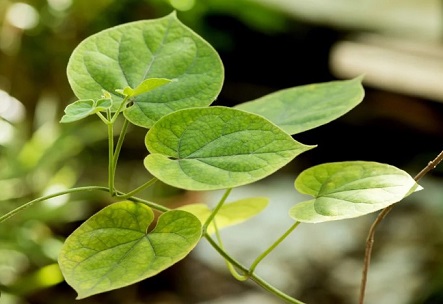Herbs And Phytochemicals: Extracts Of Cissampelos Pareira Are Neuroprotective And Can Help In Ischemic Stroke-Induced Nerve Damage
Nikhil Prasad Fact checked by:Thailand Medical News Team May 06, 2024 1 year, 6 months, 1 week, 4 days, 19 hours, 27 minutes ago
Herbs And Phytochemicals: Cissampelos pareira Linn. (Menispermaceae) has been revered in traditional medicine systems for its multifaceted therapeutic benefits, particularly in addressing various neurological disorders. Its historical use and anecdotal evidence have spurred scientific interest in exploring its neuroprotective potential, especially in conditions like ischemic stroke, where effective treatments are limited.
 Extracts Of Cissampelos Pareira Are Neuroprotective And Can Help
Extracts Of Cissampelos Pareira Are Neuroprotective And Can Help
In Ischemic Stroke-Induced Nerve Damage
Ischemic Stroke: Pathophysiology and Challenges
Ischemic stroke stands as a formidable global health challenge, accounting for significant mortality and morbidity rates. This cerebrovascular condition arises from the obstruction of blood flow to a specific brain region, triggering a cascade of pathophysiological events. These events include oxidative stress, inflammation, excitotoxicity, and ultimately neuronal death, leading to lasting neurological deficits. Despite advancements, current therapeutic options like thrombolysis have narrow efficacy windows and limited success rates, necessitating the exploration of alternative strategies.
Study Objectives
The primary aim of this
Herbs And Phytochemicals study was to conduct a comprehensive investigation into the neuroprotective effects of Cissampelos pareira, specifically focusing on its n-hexane extract, in a well-established rodent model of ischemic stroke. Our research objectives included evaluating its impact on oxidative stress, inflammation, neuronal survival, and functional outcomes following stroke induction.
Methods – Animal Model and Experimental Design
Male Sprague-Dawley rats weighing between 270-300 g were utilized to establish a permanent middle cerebral artery occlusion (MCAO) model, mimicking ischemic stroke. Animals were randomly assigned to five groups: control, MCAO, and three MCAO + Cissampelos pareira treatment groups (n-hexane, ethyl acetate (EtOAc), and methanol (MeOH) extracts), each receiving a dosage of 50 mg/kg (n = 14 per group). The experimental timeline included pre-treatment, post-stroke induction, and subsequent evaluation periods.
Evaluation Parameters
-Neurobehavioral Deficits: Comprehensive assessment of motor function, sensory perception, and coordination using standardized neurobehavioral tests.
-
Infarction Area and Neuronal Survival: Histological examination of brain tissue sections stained with 2, 3, 5-triphenyl tetrazolium chloride (TTC), hematoxylin and eosin (H&E), and Nissl staining techniques.
-Inflammatory Markers: Immunohistochemical analysis and enzyme-linked immunosorbent assay (ELISA) to quantify levels of inflammatory factors including cyclooxygenase (COX-2), c-Jun N-terminal Kinase (p-JNK), and nuclear factor kappa-ligh
t-chain-enhancer of activated B cells (p-NF-κB).
-Antioxidant Enzymes: Biochemical assays measuring activities of glutathione (GST), glutathione S-transferase (GSH), catalase (CAT), superoxide dismutase (SOD), and glutathione peroxidase (GPx).
-Phytochemical Analysis: Gas chromatography/mass spectrometry (GC-MS) analysis to identify major constituents in the n-hexane extract of Cissampelos pareira.
Results -Neuroprotective Effects
-Infarction Area Reduction: The n-hexane extract of Cissampelos pareira exhibited a significant reduction in the infarction area compared to the MCAO group, indicative of its neuroprotective potential in attenuating ischemic damage.
-Improved Neuronal Survival: Histological analysis revealed enhanced neuronal survival and preserved cellular morphology in animals treated with the n-hexane extract of Cissampelos pareira, reflecting its protective effects against neuronal death.
-Functional Recovery: Neurobehavioral testing demonstrated improvements in motor coordination, sensory responses, and overall functional recovery in the n-hexane extract-treated group.
Results-Anti-Inflammatory and Antioxidant Actions
-Suppression of Inflammatory Markers: Treatment with Cissampelos pareira significantly suppressed the MCAO-induced activation and expression levels of inflammatory markers including COX-2, p-JNK, and p-NF-κB, suggesting potent anti-inflammatory effects.
-Restoration of Antioxidant Enzymes: The n-hexane extract restored the reduced levels of antioxidant enzymes (GST, GSH, CAT, SOD, GPx) in response to ischemic injury, highlighting its antioxidant properties and ability to counteract oxidative stress.
Discussion
Mechanisms of Neuroprotection
The observed neuroprotective effects of Cissampelos pareira, particularly its n-hexane extract, can be attributed to several mechanisms:
-Anti-Inflammatory Pathways: Modulation of the JNK/NFκB/COX2 pathway, leading to reduced inflammatory responses and neuronal damage.
-Antioxidant Defense: Enhancement of antioxidant enzyme activities, mitigating oxidative stress-induced neuronal injury.
-Neurotrophic Effects: Potential promotion of neurotrophic factors and cellular repair mechanisms, aiding in neuronal survival and functional recovery.
Implications and Future Directions
The findings from this study underscore the therapeutic potential of Cissampelos pareira, specifically its n-hexane extract, as a neuroprotective agent in ischemic stroke. Further translational research, including clinical trials, is warranted to validate these results and explore the feasibility of therapeutic applications in human subjects. Additionally, elucidating the precise molecular pathways and identifying specific bioactive constituents responsible for the observed effects would be valuable for optimizing therapeutic interventions.
Conclusion
In conclusion, Cissampelos pareira, particularly its n-hexane extract, exhibits robust neuroprotective properties in ischemic stroke models. Its ability to mitigate oxidative stress, suppress inflammation, promote neuronal survival, and facilitate functional recovery positions it as a promising candidate for further therapeutic development. Continued research endeavors are essential to unlock its full therapeutic potential and advance its clinical utility in improving outcomes for ischemic stroke patients.
The study findings were published in the peer reviewed journal: Natural Product Communications (Sage Journals).
https://journals.sagepub.com/doi/full/10.1177/1934578X241249069
For the latest on
Herbs And Phytochemicals, keep on logging to Thailand Medical News.
